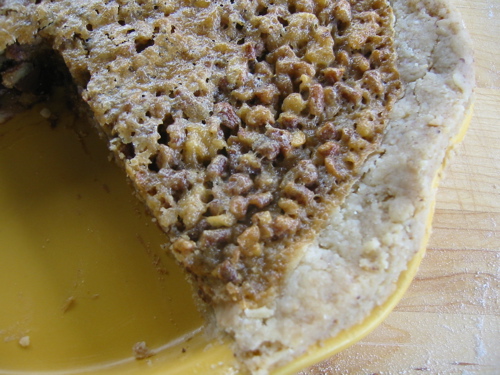The Tender and the Flaky

So what other kinds of baked goodies are out there that employ mechanical leavening and mechanical leavening alone? Though you might not think it, pie crusts. True they don’t rise nearly as dramatically as laminated doughs, yet the whole concept of pie crust “flakiness” is a product of the same principle: large (or at any rate large-ish) pockets of fat melt away, leaving spaces that fill with steam. Though because pie crusts contain so much fat, there is very little flour-and-water “structure” to hold the steam bubbles in place. So nearly all of it escapes.
This crust is even more inhospitable to structure, and hence bubbles, than a traditional crust in that it also contains ground pecans. It’s more crumbly than flaky. What’s it for? A Derby pie (though you can’t be a baker and say “Derby” pie in Lousiville without getting your hind-end sued off) recipe I’m testing (yes, for that same book). Derby pie is a very rich bit of bakery that’s related to Appalachain butter pie (which is very similar in its makeup to a Canadian butter tart), except that it contains chocolate pieces and booze.
The truly old-school versions of these pies called for lard crusts, which puts a body into fat overload (believe me, I’ve tried it). Though lard crusts are much flakier as a rule than butter crusts. Why? Because unlike butter, lard has no water in it, just fat. And that’s a big advantage for reasons I spelled out yesterday in Laminated Dough: The Moisture Issue.